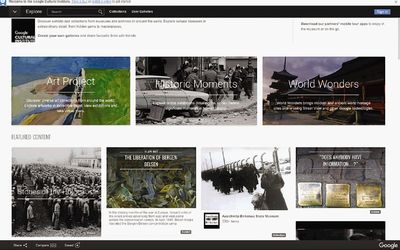THE rise of the internet and new web technologies have had profound consequences for art curating. Museums and art institutions are adopting new technologies, creating new experiences for audiences and publics and prompting fresh practical and intellectual challenges. In addition, there has been a rise in online-only exhibitions.
Art history academics have long critiqued the role of the curator as mediator, author, undertaker and iconoclast among others.
Today, the use of new technologies in exhibition and curatorial practice adds a complex mediating dynamic to the curator’s role, as the relationship between the virtual and physical assumes an increasingly important place.
Since the late 1990s, understanding how institutions deploy technology and, conversely, understanding online audience behaviour, has become a new profession and area of expertise. Museums are using the web and social media in new ways, and this affects the public’s access and experience of exhibitions and related information.
Most often, virtual displays complement real displays, or provide a window into collections that are not on permanent display. The web has often been seen as the answer to the "problem" of museums or institutions not having enough physical space to do justice to vast collections.
...
Take a look at the Google Cultural Institute website, which houses dozens of examples of online collections shared by renowned global art institutions, ranging from MoMA to Tate Britain.
Most museums now have a website. But what kind of information do they disseminate, and what are their intentions? Does the site include only basic information for visitors, or does it present images of some or all of a current exhibition?
Does it have repositories and/or online-only exhibitions? Is the real exhibition echoed by an online exhibition, and how long does the online exhibition "live"? What does this mean for how exhibitions are remembered in history, and by whom?
There are more questions. Once exhibition-related content is brought onto the web, what kind of online visitor behaviour is subsequently observed?
Does the website provide opportunities for online visitors to interact with or respond to these images — to leave comments, for example, save an image to their own technology device, or share what they find via social media?
Where do online visitors come from and how does this differ from real visitors? How long do they visit the website, where exactly do they spend their time? Do they visit only once or do they come back for more?
Research shows that online and real museum visitors are not separate entities, and museum professionals need to understand how to develop a complementary relationship between a museum’s physical space and its website.
Art and museum curators’ fears about online exhibitions being a "competitive replica" of the real thing — and thus dissuading in-person visits — have proved to be unsubstantiated.
...
THIS is a critical point for curators: that real and virtual exhibits very often have different audiences. Virtual exhibits were originally seen as complementary to real exhibits, but it may be better to understand them as independent entities.
The web has often been heralded as a new form of democracy. For museum and gallery experiences, participatory technologies can and do subvert the "traditional" unidirectional relationship between the gallery and its audience.
Mobile videos and YouTube have revolutionised what is publicly remembered about exhibition openings, for example.
This, in turn, is shaping institutional and curatorial practices.
As wider access to information has challenged the status quo narratives of states and companies, peer-to-peer communication is often more trusted than that from an institution. Curators and institutions can now better measure whether intended curatorial "messages" have been effectively communicated — or not.
Yet the access to information provided by the web, and its accompanying strands of democratisation, are unequal, particularly in Africa’s less developed economies. Internet access across the continent continues to rise each year, but significant inequalities persist.
Access to connectivity is one matter; internet speed and loading time also become critical for the online presentation of high-resolution images. A few seconds can be the difference between an online visitor staying on the website or leaving it.
There are also related questions about the resources required to create online museum platforms and exhibitions. Who creates them, what skills and education do such people require, and do individuals and institutions in countries such as SA have the necessary resources?
One of the greatest practical advantages of the digital world, long proclaimed by web evangelists, especially for exhibitions focused on historical archival materials, is that it creates a safe environment for fragile and priceless materials to be displayed.
For example, the Dead Sea Scrolls and minuscule letters that Nelson Mandela smuggled out of prison can be viewed online.
One of the biggest disadvantages, however, is the difficulty of presenting a tactile material via a digital format. What does it mean not to have a physical experience of a work of art? How does a viewer really judge and experience scale?
A recent Hiscox survey reported this to be a hurdle for online art buyers and, although not conclusive, it suggests that visitors to an online exhibition may perceive their experience to be limited or negatively affected. This may be particularly so for three-dimensional objects or multimedia materials with strong textural qualities.
...
EXHIBITIONS tell stories, and galleries are narrative spaces. In the same way that physical spaces present conundrums for curators, so do online spaces. To what extent does the curator guide the visitor’s path, or alternatively, give them free rein to move in several possible directions? How does this work for an online environment?
How does a curator take into consideration the fact that an online visitor may at any point be easily distracted from the tab at hand, by other (nonart) online offerings that are only a click away?
As described by Achille Mbembe, any exhibition, like the historical archive, is "a product of judgment, which involves placing certain documents in an archive at the same time as others are discarded".
Inclusions and exclusions come to bear on how knowledge of the past and present is produced; likewise for online practices. Online curation and new technologies have the potential to help reimagine, recontextualise and represent the items or artworks in an exhibition. Digitisation projects are not simply about technical matters of preservation and access, but the production of new forms of knowledge.
The web can prolong the life of an exhibition, and in turn, public engagement and memory of that exhibition and its art. The economic and intellectual effort behind an exhibition may also be extended.
If curators are already agents with their own agendas, then the incorporation of technology creates additional layers of contestation, creating a "double layer" of mediation between art and audiences. This is particularly so in a global environment in which online conversations are not unidirectional but rather many-to-many.
• Taylor is founder and director of Guns & Rain, an online platform for African contemporary art

A screen grab of a website. Virtual displays can benefit real displays but a complementary relationship needs to be developed between the physical space and website. Picture: GOOGLE CULTURAL INSTITUTE
THE rise of the internet and new web technologies have had profound consequences for art curating. Museums and art institutions are adopting new technologies, creating new experiences for audiences and publics and prompting fresh practical and intellectual challenges. In addition, there has been a rise in online-only exhibitions.
Art history academics have long critiqued the role of the curator as mediator, author, undertaker and iconoclast among others.
Today, the use of new technologies in exhibition and curatorial practice adds a complex mediating dynamic to the curator’s role, as the relationship between the virtual and physical assumes an increasingly important place.
Since the late 1990s, understanding how institutions deploy technology and, conversely, understanding online audience behaviour, has become a new profession and area of expertise. Museums are using the web and social media in new ways, and this affects the public’s access and experience of exhibitions and related information.
Most often, virtual displays complement real displays, or provide a window into collections that are not on permanent display. The web has often been seen as the answer to the "problem" of museums or institutions not having enough physical space to do justice to vast collections.
...
Take a look at the Google Cultural Institute website, which houses dozens of examples of online collections shared by renowned global art institutions, ranging from MoMA to Tate Britain.
Most museums now have a website. But what kind of information do they disseminate, and what are their intentions? Does the site include only basic information for visitors, or does it present images of some or all of a current exhibition?
Does it have repositories and/or online-only exhibitions? Is the real exhibition echoed by an online exhibition, and how long does the online exhibition "live"? What does this mean for how exhibitions are remembered in history, and by whom?
There are more questions. Once exhibition-related content is brought onto the web, what kind of online visitor behaviour is subsequently observed?
Does the website provide opportunities for online visitors to interact with or respond to these images — to leave comments, for example, save an image to their own technology device, or share what they find via social media?
Where do online visitors come from and how does this differ from real visitors? How long do they visit the website, where exactly do they spend their time? Do they visit only once or do they come back for more?
Research shows that online and real museum visitors are not separate entities, and museum professionals need to understand how to develop a complementary relationship between a museum’s physical space and its website.
Art and museum curators’ fears about online exhibitions being a "competitive replica" of the real thing — and thus dissuading in-person visits — have proved to be unsubstantiated.
...
THIS is a critical point for curators: that real and virtual exhibits very often have different audiences. Virtual exhibits were originally seen as complementary to real exhibits, but it may be better to understand them as independent entities.
The web has often been heralded as a new form of democracy. For museum and gallery experiences, participatory technologies can and do subvert the "traditional" unidirectional relationship between the gallery and its audience.
Mobile videos and YouTube have revolutionised what is publicly remembered about exhibition openings, for example.
This, in turn, is shaping institutional and curatorial practices.
As wider access to information has challenged the status quo narratives of states and companies, peer-to-peer communication is often more trusted than that from an institution. Curators and institutions can now better measure whether intended curatorial "messages" have been effectively communicated — or not.
Yet the access to information provided by the web, and its accompanying strands of democratisation, are unequal, particularly in Africa’s less developed economies. Internet access across the continent continues to rise each year, but significant inequalities persist.
Access to connectivity is one matter; internet speed and loading time also become critical for the online presentation of high-resolution images. A few seconds can be the difference between an online visitor staying on the website or leaving it.
There are also related questions about the resources required to create online museum platforms and exhibitions. Who creates them, what skills and education do such people require, and do individuals and institutions in countries such as SA have the necessary resources?
One of the greatest practical advantages of the digital world, long proclaimed by web evangelists, especially for exhibitions focused on historical archival materials, is that it creates a safe environment for fragile and priceless materials to be displayed.
For example, the Dead Sea Scrolls and minuscule letters that Nelson Mandela smuggled out of prison can be viewed online.
One of the biggest disadvantages, however, is the difficulty of presenting a tactile material via a digital format. What does it mean not to have a physical experience of a work of art? How does a viewer really judge and experience scale?
A recent Hiscox survey reported this to be a hurdle for online art buyers and, although not conclusive, it suggests that visitors to an online exhibition may perceive their experience to be limited or negatively affected. This may be particularly so for three-dimensional objects or multimedia materials with strong textural qualities.
...
EXHIBITIONS tell stories, and galleries are narrative spaces. In the same way that physical spaces present conundrums for curators, so do online spaces. To what extent does the curator guide the visitor’s path, or alternatively, give them free rein to move in several possible directions? How does this work for an online environment?
How does a curator take into consideration the fact that an online visitor may at any point be easily distracted from the tab at hand, by other (nonart) online offerings that are only a click away?
As described by Achille Mbembe, any exhibition, like the historical archive, is "a product of judgment, which involves placing certain documents in an archive at the same time as others are discarded".
Inclusions and exclusions come to bear on how knowledge of the past and present is produced; likewise for online practices. Online curation and new technologies have the potential to help reimagine, recontextualise and represent the items or artworks in an exhibition. Digitisation projects are not simply about technical matters of preservation and access, but the production of new forms of knowledge.
The web can prolong the life of an exhibition, and in turn, public engagement and memory of that exhibition and its art. The economic and intellectual effort behind an exhibition may also be extended.
If curators are already agents with their own agendas, then the incorporation of technology creates additional layers of contestation, creating a "double layer" of mediation between art and audiences. This is particularly so in a global environment in which online conversations are not unidirectional but rather many-to-many.
• Taylor is founder and director of Guns & Rain, an online platform for African contemporary art























Change: -0.96%
Change: -1.03%
Change: -0.98%
Change: -0.67%
Change: -2.18%
Data supplied by Profile Data
Change: -0.57%
Change: 0.47%
Change: -0.96%
Change: 0.00%
Change: 0.44%
Data supplied by Profile Data
Change: -0.68%
Change: -0.67%
Change: -0.37%
Change: -0.68%
Change: -0.68%
Data supplied by Profile Data
Change: 0.75%
Change: 1.25%
Change: 0.99%
Change: 1.07%
Change: -0.61%
Data supplied by Profile Data